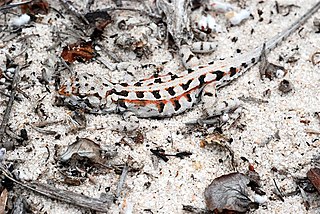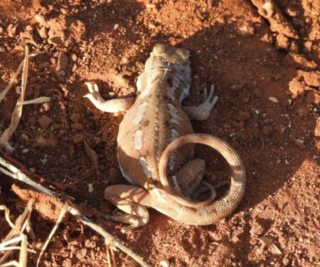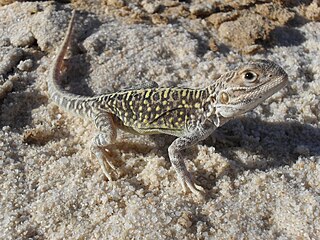
Ctenophorus is a genus of lizards, commonly known as comb-bearing dragons, found in Australia. They are in the dragon lizard family, known as Agamidae.

Ctenophorus reticulatus, the western netted dragon or western netted ground-dragon, is a species of lizard in the family Agamidae. It is found in South Australia, Western Australia and southern Northern Territory.

The Mallee dragon, also commonly known as the Mallee dragon and the Mallee sand-dragon, is a species of lizard in the family Agamidae. The species is native to the arid parts of southern Australia.

Ctenophorus gibba, commonly known as the bulldust ground-dragon or gibber dragon, is a species of agamid lizard occurring in the sparsely vegetated gibber plains of northern South Australia.

Ctenophorus isolepis, commonly known as the central military dragon, military dragon or military sand dragon, is a species of agamid lizard occurring in the arid parts of central and western Australia.

Ctenophorus rubens, commonly known as the reddening sand-dragon or rufus sand dragon, is a species of agamid lizard occurring in the arid sandy areas of shrublands and spinifex of the Exmouth Gulf and the adjacent interior of Western Australia, with an isolated population also occurring in the sand dunes south of Hamelin Pool, Western Australia. It was formerly considered to be a subspecies of C. isolepis.

Ctenophorus adelaidensis, commonly known as the western heath dragon is a species of agamid lizard occurring in sandplains with heath and banksia along the lower coast of Western Australia, between Kalbarri and Perth. Adults are grey in colour, with dark blotches. They are relatively slow compared to other Ctenophorus species, preferring to scuttle rather than sprint.

Ctenophorus butlerorum, also known commonly as Butler's dragon, the Shark Bay heath dragon and the Edel heath dragon, is a species of lizard in the family Agamidae. The species is endemic to Australia.

Ctenophorus chapmani, commonly known as Chapman's dragon, southern heath dragon, or Bight heath dragon, is a species of agamid lizard occurring in sandplains with heath or mallee across southern Australia.
Ctenophorus clayi, also known commonly as the black-collared dragon, the black-shouldered ground-dragon, and Clay's dragon, is a species of lizard in the family Agamidae. The species is endemic to Australia.

Ctenophorus cristatus, commonly known as the crested dragon, bicycle dragon or crested bicycle-dragon, is a species of agamid lizard occurring in semi-arid woodlands in south-western Australia.
Ctenophorus femoralis, the long-tailed sand dragon, is a species of agamid lizard occurring on spinifex covered sand-ridges and sand-plains on the arid mid-western coast of Western Australia.

Ctenophorus maculatus, commonly known as the spotted military dragon, spotted dragon, or spotted sand-dragon is a species of agamid lizard occurring in semi-arid to arid shrublands and hummock grasslands of Western Australia and a small part of South Australia.
Ctenophorus mckenziei, more commonly known as the dwarf-bicycle dragon, is a species of endemic Australian lizard within the family Agamidae and genus Ctenophorus. Originally identified as the agamid Amphibolurus mckenziei, the lizard had been identified within the regions of Western Australia and South Australia in which it occupied the shrubbery and woodland areas as its habitat. It was subsequently transferred to the genus Ctenophorus along with other Agamid species in which it shared similar morphology and characteristics. The name mckenziei is in reference to Norman Leslie Mckenzie, who was a zoologist and discovered the existence of the lizard. Listed on the IUCN red list page, threats to its population numbers are evaluated as least concern; however, their numbers are threatened by habitat loss, climate change, and feral predators.
Ctenophorus nguyarna, commonly known as the Lake Disappointment dragon is a species of agamid lizard occurring in low samphire shrubs fringing the remote Kumpupintil Lake, Western Australia.

Ctenophorus parviceps, commonly known as the Gnaraloo heath dragon or northwestern heath dragon is a species of agamid lizard occurring in pale coastal sands and shell grit with open heaths and beach spinifex, between the North West Cape and Carnarvon, Western Australia and on Bernier Island. The Gnaraloo heath dragon is a lizard that can be found along the coast of Western Australia between Exmouth Gulf and Shark Bay, and is also known as the northwestern heath dragon. It is native to Australia and usually inhabits sandy coastal dunes. The species' longevity is 3–50 years and its population density is extremely low. The Gnaraloo heath dragon is a member of the Agamidae family, which contains 15 genera. The lizard is under the Ctenophorus genus which has up to 33 species. This genus shows the most morphological and ecological diversity out of the three large agamid genera. 83% of the lizards in this genus lack a crest, while 17% possess crests. They are smaller than most agamids but do have relatively large heads. The Gnaraloo heath dragon can be differentiated from related species by a series of spines on the tail's base, a pale-grey brown broad vertebral band along its back, and hour-glass bars extending upwards to meet the pale vertebral band. It is usually 45mm in terms of length, measuring from snout to vent.
Ctenophorus scutulatus, commonly known as the lozenge-marked dragon or lozenge-marked bicycle-dragon is a species of agamid lizard occurring in semi-arid to arid zones on hard to stony soils supporting acacia woodlands and chenopod shrublands in Western Australia.

Ctenophorus salinarum, commonly known as the claypan dragon or saltpan ground-dragon is a species of agamid lizard occurring in arid to semi-arid chenopod shrublands around salt lakes and claypans and in adjacent sandy heaths in southern Western Australia.

Ctenophorus tjantjalka, also known as the ochre dragon, is a species of agamid lizard occurring on low, weathered, crumbling outcrops and stony hills in arid South Australia, from the Painted Hills north-west to the base of the Everard Ranges.

Ctenophorus vadnappa, commonly known as the red-barred dragon or red-barred crevice-dragon is a species of agamid lizard occurring in rocky outcrops and ranges in semi-arid to arid South Australia, from the northern Flinders Ranges to hills north of Lake Torrens.















